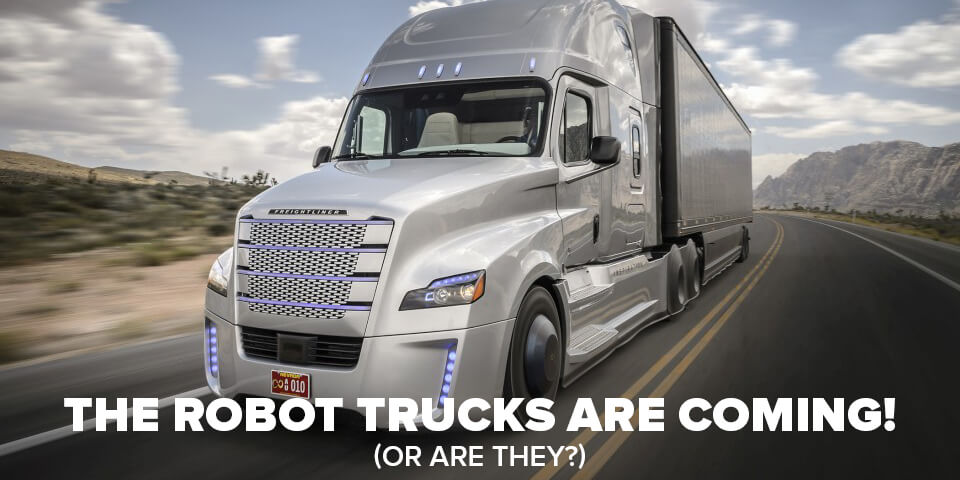In The News

The Robot Trucks are Coming! (Or, Are They?)
Ever wonder why there hasn’t been as much talk lately about how self-driving trucks are “right around the corner,” poised to eliminate four-million trucker jobs in the U.S.?
I was wondering the same thing. So, I tested my hypothesis.
If you ever want to put your finger on the pulse of specific trends, go to Google News. Then search the topic you’re interested in, and there you have it: the latest headlines on that topic.
My search: “self-driving trucks eliminate trucking jobs.”
The results didn’t surprise me.
Sure, there were still a handful of headlines sounding the alarms about robots ruling the roads, like these:
- Could Driverless Vehicles Spell the End of the Road for Truck Drivers (PBS, December 2018)
- Highest-Paid Truck Drivers May Be Replaced by Autonomous Vehicles (Fox Business, September 2018)
- Death of the American Trucker (Rolling Stone, January 2018).
But notice the dates. None were published in 2019. I had to scroll down quite a bit to find these articles.
The more recent headlines, however, look more like these:
- Automation is inevitable but will not displace driver jobs: IRU’s global innovation head (January 2019)
- Myth busting: Robots Won’t Replace Truck Drivers (Trucks.com, January 2019)
- Even with self-driving vehicles, the future of CDL drivers is brighter than you think (Baltimore Post-Examiner, April 2019).
What happened? Why the change in media coverage and sentiment from inevitable doom to “Robots Won’t Replace Truck Drivers” or “the future...is brighter than you think”?
The Turning Point
The shift began shortly after March 18, 2018—the date that will live in infamy as the first recorded case of a pedestrian fatality involving a self-driving vehicle.
Elaine Herzberg was walking her bicycle across a Tempe, Arizona street when the radar and LiDAR of a Uber-owned autonomous Volvo XC90 SUV failed to “see” Herzberg and fatally struck her.
According to Tempe police, the safety driver was streaming video on her phone at the time and didn’t hit the brakes until less than a second after the collision.
This incident caused Uber to stop their self-driving testing program in Arizona.
Then, just five days later, on March 23, 2018, the driver of a Telsa Model X was killed after colliding with a freeway median barrier while the vehicle’s Autopilot was engaged.
The next month, in June, one of Waymo's self-driving Chrysler Pacifica minivans crashed on the freeway outside the company's office in Mountain View, California. The lone safety driver fell asleep at the wheel and inadvertently pressed the gas pedal, which disengaged the vehicle's self-driving mode. Fortunately, the safety driver wasn't hurt, and no other vehicles were involved.
But the impact of these high-profile collisions in short succession caused the industry to take a step back to reflect: “Are we racing too fast toward full autonomy at the expense of safety?”
The Slow(er) Roll to Self-Driving
Today, most companies in the self-driving space are setting more sober expectations compared to the year or so leading up to Herzberg’s death in March 2018.
For example, when Raquel Urtasun, chief scientist at Uber Advanced Technologies Group (ATG), spoke about the challenges for self-driving development at a Reuters Newsmaker event in New York this April, she said, “Self-driving cars are going to be in our lives. The question of when is not clear yet. To have it at scale is going to take a long time.”
At a Detroit Economic Club event in April, Jim Hackett, chief executive officer at Ford Motor Co., said that too much hype had been built up around how soon self-driving cars will hit the road. “We overestimated the arrival of autonomous vehicles,” said Hackett. While Ford’s first self-driving car is still coming in 2021, “its applications will be narrow, what we call geo-fenced, because the problem is so complex.”
Tesla is the lone player in this space saying that “full self-driving” is imminent.
On April 22, at an investor event that Tesla promoted as "Autonomy Day," CEO Elon Musk said that Tesla would have a million “robotaxis” on the road next year, meaning a million truly autonomous cars that can operate commercially in a ride-hailing network, generating passive income for their owners.
Industry analyst sentiment was generally skeptical.
Tesla investors and analysts—no media members were invited—had the opportunity to ride in the cars in “full self-driving” mode but were not permitted to film the drive. The experience left some analysts with more questions than answers.
As reported by CNBC, Deutsche Bank analyst Emmanual Rosner, who took a test drive of the vehicles Tesla showed on Tuesday, said, “Given our own test ride still faced issues despite being on a pre-planned course and under relatively simple road conditions, we believe the company’s targeted timeline for both full self-driving and its robotaxi service is at the very least aggressive. Ultimately, we still wonder whether Tesla can even solve the large challenges of fully autonomous driving with its vision-based approach alone.”
The Bottom Line
The future of trucking will likely be self-driving—at least, to some degree.
But it may take much longer than the industry had predicted to get to fully (Level 5) autonomy, where the vehicle can handle any and all driving situations without the need for human driver intervention.
That’s because, as technologists and automakers have discovered, human drivers (for the most part) are amazing—and very hard to fully replicate with software.
So, keep watching this space. The most likely near-term scenario is not that robots will rule the road by themselves, but that human drivers and their increasingly automated trucks will need to learn how to work together to make the roads safer.
